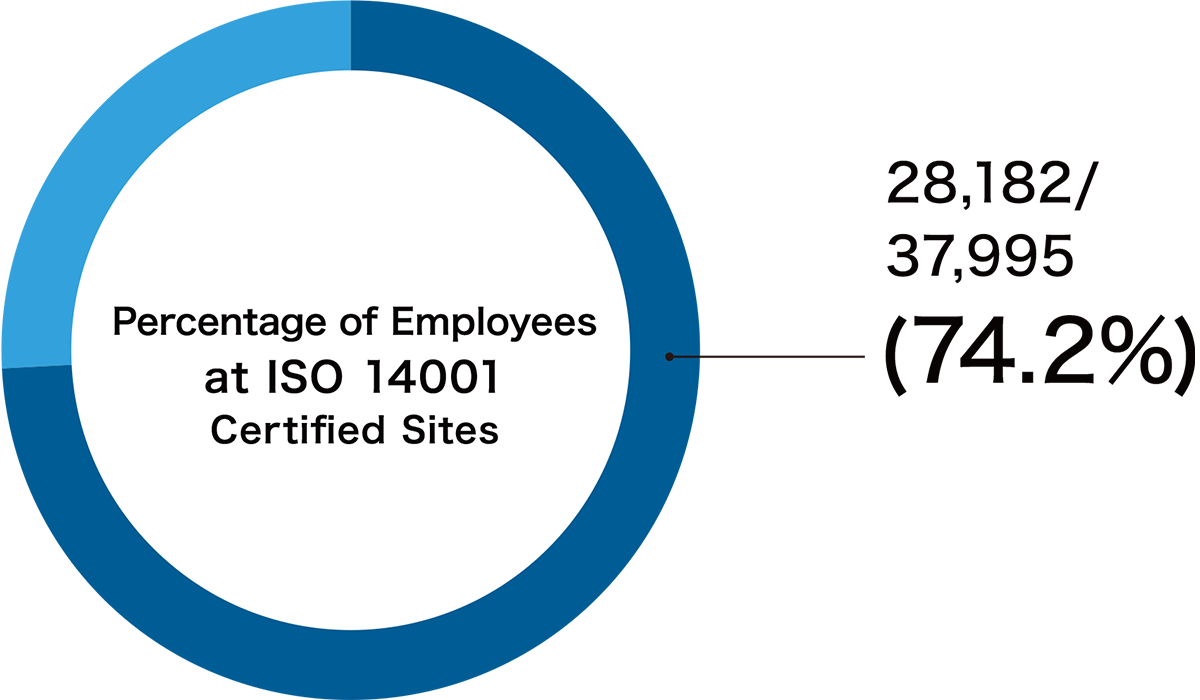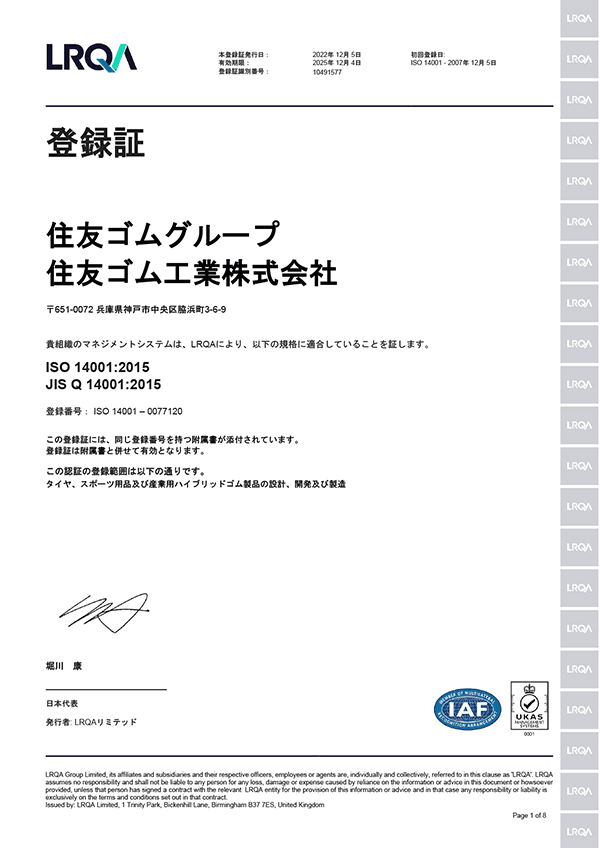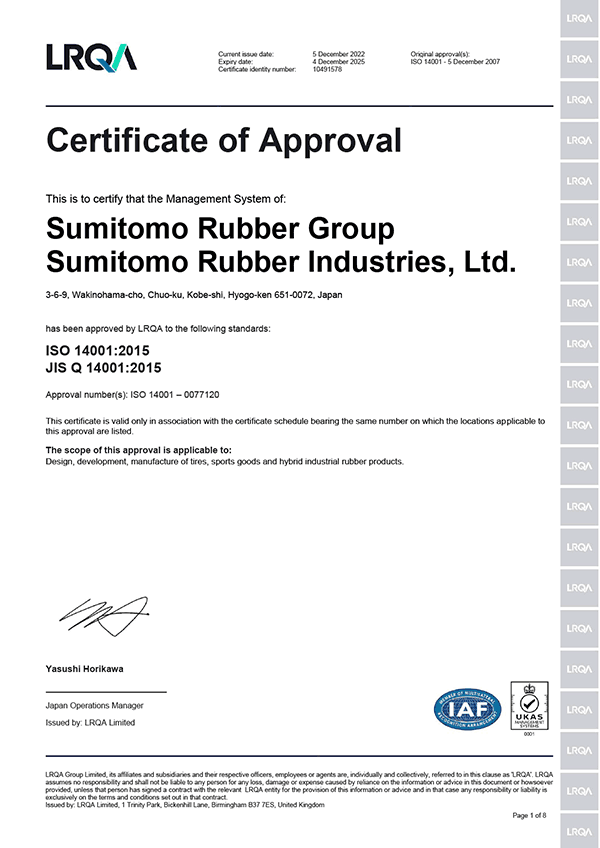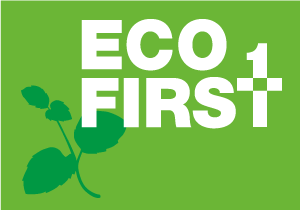The Sumitomo Rubber Group places great emphasis on conducting sustainable business operations while coexisting harmoniously with society and the environment. In December 2020, we established a new corporate philosophy system, “Our Philosophy,” as a driving and accelerating force toward realizing our corporate strategy. We defined our Purpose—our reason for being—as “Creating the ultimate reassurance and joy through innovation that opens the future.”
By making this Purpose the foundation for all decision-making and the starting point for our actions, we are committed to enhancing not only economic value but also social value, thereby contributing to the development of a sustainable society. Environmental conservation is one of the shared and critical responsibilities that corporations must fulfill globally. As a global company, our group actively promotes environmental management at all its locations around the world.
The Group established its Environmental Policy, which is aimed at realizing a sustainable society, in July 2007 as a Group policy for realizing a sustainable society (revised in December 2024)
The policy clearly states the environmental issues to be addressed and the measures to be taken, and the Group is working to realize decarbonization and reduce environmental burden.
We will continue to resolve environmental issues across our supply chain and live up to our stakeholders’ expectations to ultimately enhance our corporate value.
Our corporate group spearheads initiatives for integrated environmental management through the Sustainability Management Promotion Headquarters, in collaboration with top management and various departments. To drive sustainability management, we convene the “Sustainability Promotion Committee”—chaired by the Executive Director in Charge of Sustainability and joined by officers in charge of respective divisions—twice a year. The committee ensures the alignment of company-wide policies and monitors progress on material issues. Under the umbrella of the Sustainability Promotion Committee, we have established the Sustainability Promotion Working Group (WG). Among its subgroups, the Environmental Management System (EMS) Division operates as a cross-functional organization to advance these efforts.
The Sumitomo Rubber Group has obtained the international standard ISO 14001 certification to continue to improve our environmental management system against environmental targets through a PDCA cycle. We have operated and implemented the Environmental Management System (EMS) based on the standard.
We have added one more certified site during fiscal 2024, bringing the total number of sites under multi-site certification to 35 at the end of 2024, with 94.6% of our sites certified.
Moreover, the ratio (percentage) of employees working at these sites to total employees has reached 74.2%.
We subjected uncertified manufacturing sites to environmental corporate audits conducted in a manner similar to those conducted at certified sites in order to strengthen our environmental management structure.



The Sumitomo Rubber Group’s certificate for the global multi-site certification (above: Japanese version; below: English version)
| Name of Site | Year of Certification | The Global Multi-Site Certification | |
|---|---|---|---|
| Tire Business HQ, Sumitomo Rubber Industries, Ltd. | Head Office | 2007 | ◯ |
| Tyre Technical Center | 2007 | ◯ | |
| Okayama Tyre Proving Ground | 2007 | ◯ | |
| Shirakawa Factory | 1997 | ◯ | |
| Nagoya Factory | 1997 | ◯ | |
| Izumiotsu Factory | 1998 | ◯ | |
| Miyazaki Factory | 1997 | ◯ | |
| Hybrid Rubber Products HQ, Sumitomo Rubber Industries, Ltd. | Kakogawa Factory | 1998 | ◯ |
| Izumiotsu Factory | 1998 | ◯ | |
| Sports Business HQ, Sumitomo Rubber Industries, Ltd. | Golf Science Center | 1998 | ◯ |
| Nakata Engineering Co., Ltd. | Head Office and Factories | 2004 | ◯ |
| SRI Engineering, Ltd. | Head Office | 2009 | ◯ |
| Kakogawa Business Base | 2009 | ◯ | |
| Seishin Business Base | 2009 | ◯ | |
| SRI Business Associates Co., Ltd. | Head Office | 2009 | ◯ |
| SRI Systems Ltd. | Head Office | 2009 | ◯ |
| SRI Logistics Ltd. | Head Office | 2009 | ◯ |
| Dunlop Retread Service Ltd. | Head Office and Ono Factory | 2010 | ◯ |
| Hokkaido Factory | 2010 | ◯ | |
| Dunlop Golf Club, Ltd | Head Office and Factories | 2010 | ◯ |
| Changshu Factory, China | 2005 | ◯ | |
| Indonesia Factory | 2003 | ◯ | |
| Thailand Factory | 2008 | ◯ | |
| Zhongshan Factory, China | 2004 | ◯ | |
| Vietnam Factory | 2008 | ◯ | |
| Malaysia Factory | 2005 | ◯ | |
| Thailand Factory (tennis balls) | 2009 | ◯ | |
| Thailand Factory (natural rubber processing) | 2012 | ◯ | |
| Sumitomo Rubber (China) Co., Ltd. | 2013 | ◯ | |
| Hunan Factory, China | 2013 | ◯ | |
| Brazil Factory | 2014 | ◯ | |
| Brazil Factory | 2016 | ◯ | |
| USA Factory | 2013 | ◯ | |
| South Africa Factory | 2012 | ◯ | |
| DUNLOP TECH GmbH | 2014 | ◯ | |
(As of December 2024)
The Sumitomo Rubber Group continues to reduce its environmental impact under the Environmental Policy set by top management, utilizing the PDCA cycle established based on ISO 14001 integrated certification and tailored to the characteristics of each base of operations.
In addition to reducing total CO2 emissions, water consumption, and waste volume across the entire Group, we are promoting communication within and outside the organization to ensure a transition to a carbon-neutral and circular economy.
Sustainability-related risks that may materially and adversely affect our business activities shall be addressed by each of the relevant divisions and/or subsidiaries in advance, through the analysis of those risks and the planning of countermeasures in accordance with the Regulations Concerning Risk Control, which define risk management methods for the entire Sumitomo Rubber Group. These risks shall then be referred to the Management Meeting and other bodies for discussion. In addition, the management team monitors and reviews the themes that they believe are especially important in reducing burdens on society and the environment in the Company’s supply chain as well as the global supply chain. The results are reported to the Board of Directors.
The Sumitomo Rubber Group was certified in March 2009 as an “Eco-First company” under the “Eco-First Program” established by the Ministry of the Environment, and renewed its “Eco-First Commitments,” which summarize fresh targets for environmental preservation, in October 2022.
In light of the increasing seriousness of global social issues, including climate change and other environmental concerns, we also came to the conclusion that a new policy, one based on long-term perspectives that look to the world of 2050 and beyond, would be essential to our efforts to ensure the sustained growth and development of both our group and society as a whole. The Long-Term Sustainability Target : “Driving Our Future Initiatives 2050” was thus formulated and announced in August 2021. The updated “Eco-First Commitments” include our carbon neutrality targets for 2050 (Scope 1 + 2) and other environmental targets identified by this Long-Term Sustainability Policy.
The Eco-First Commitments are commitments delivered by corporations engaged in cutting-edge, unique and industry-leading initiatives in the environmental field to the Minister of the Environment. Activities covered by these commitments include global warming countermeasures, waste reduction, resource recycling and other voluntary corporate initiatives aimed at protecting the environment.

The Sumitomo Rubber Group has been continuously monitoring and managing various environmental load substances generated by its business activities to prevent their environmental impact.
The targets and results are as follows.
| 2024 target | Maintaining ISO 14001 global multi-site certification |
|---|---|
| 2024 result | Maintained ISO 14001 global multi-site certification |
| 2025 target | Maintaining ISO 14001 global multi-site certification (renewal audit) |
| Medium- to long-term target | Maintaining ISO 14001 global multi-site certification |
Every year, the Sumitomo Rubber Group undergoes third-party audits provided by a certification body, while employees qualified as internal auditors conduct internal audits at each business base. Moreover, since fiscal 2009, auditors from the Head Office of Sumitomo Rubber Industries, Ltd. have performed corporate audits of Group manufacturing bases at home and abroad once a year in principle.
In addition, third-party audits undertaken in fiscal 2024 revealed that all business bases earned favorable ratings, enabling them to renew Global Multi-Site Certification for ISO 14001: 2015.
Moreover, no serious violations of environment-related laws and regulations were detected via external examinations or internal audits.
Tires are the only components in a vehicle that contact the road surface. For tires to run (start moving), turn, and stop while supporting the load of a vehicle, friction between tires and the road surface is physically inevitable. TRWP refer to tire and road wear particles generated by such friction, and are a mixture of tire tread materials and road pavement materials.
Many are still unknown as to characteristics of TRWP and their possible impact on the environment. We recognize that it is highly important that we clarify them and reduce their impact on the environment.
Sumitomo Rubber Industries is one of the founding members of the WBCSD’s*2 TIP*3, an industry association consisting of 10 global tire manufacturers. We have been involved in activities such as research and studies on TRWP, the establishment of evaluation methods, and dialogues with stakeholders. In addition to tackling the issue of TRWP, the TIP currently strives to address universal sustainability concerns of the tire industry such as the management of waste tires, the issues related to raw materials and chemicals and visualization of environmental KPIs.
Sumitomo Rubber Industries is also a member of the JATMA*4 and JRMA*5, working on developing ISO standards related to the assessment of TRWP and other efforts.
*1 Tire and Road Wear Particles
*2 World Business Council for Sustainable Development
*3 Tire Industry Project
*4 The Japan Automobile Tyre Manufacturers Association, Inc.
*5 The Japan Rubber Manufacturers Association
6PPD (N-(1,3-dimethylbutyl)-N’-phenyl-p-phenylenediamine) is an anti-degradant used widely in the tire industry. In recent years, an article that suggests that 6PPD-quinone formed when 6PPD reacts with oxygen or ozone in the air is harmful to some aquatic organisms was published.
Triggered by the publication, the process for regulating 6PPD is currently underway in the U.S. Meanwhile, 6PPD itself plays an important role in preventing cracks in tires produced when rubber reacts with oxygen or ozone in the environment to retard deterioration from aging. As such, 6PPD is essential for tires to fully demonstrate their performance and for customers to use tires with a sense of safety for many years. Currently, the tire industry as a whole is examining the possible replacement with alternative technologies as well as developing/evaluating alternative products. Our Company has joined in promoting such industry-wide initiatives.
Artificial turf used in sporting facilities is now considered a possible source of microplastic*1 dispersion into rivers and the sea, as, with use over time, turf fibers break and the rubber chips used as fillers may leak, spreading into the environment. Since 2020, we have been working to confirm the status of runoff and develop materials and products that are highly effective in controlling runoff. We propose that facility operators use artificial turf perimeter layouts that have been confirmed effective in managing runoff and install filter materials in drainage ditches. As a result, measures to prevent runoff that are gradually being implemented.
We will continue to develop and improve runoff prevention technologies and promote the spread of countermeasures. Our efforts have been featured in an article by the Ministry of the Environment *2. They are also introduced in guidelines for measures against microplastics derived from artificial turf *3, *4
*1 Small pieces of plastic that have a diameter less than 5 mmm
In fiscal 2024, one instance of legal non-compliance occurred at our manufacturing facilities due to a delayed administrative filing (China, Changshu Plant, fine: 296,000 yuan). We promptly collaborated with local authorities to resolve the issue and conducted a root cause analysis. Based on these findings, we implemented measures to prevent similar occurrences at other facilities.
Other than CO2, the Sumitomo Rubber Group’s GHG emissions consist of methane, dinitrogen monoxide, fluorocarbons, and sulfur hexafluoride.
As for fluorocarbons, we conduct the maintenance and periodic inspection of relevant equipment in accordance with the Act for Rational Use and Proper Management of Fluorocarbons while regularly calculating the volume of activities and leakage. With regard to the mandatory reporting of the calculated amount of leaked fluorocarbons, no applicable incident occurred during fiscal 2024.
The Sumitomo Rubber Group keeps equipment with PCB content, such as transformers, condensers, and stabilizers, at domestic factories in a way that complies with the Act on Special Measures concerning Promotion of Proper Treatment of PCB Wastes*2. The Group also reports them to the administrative authorities.
In 2024, the disposal results were one transformer, three capacitors, and one series reactor.
As of the end of 2024, equipment with PCB content kept by the Group consisted of 35 stabilizers and two devices with low-concentration PCB, including transformers.
As for the remaining two devices with low-concentration PCB, we will systematically work to complete their disposal by the March 31, 2027, deadline.
*1 Generic term for polychlorinated biphenyl. PCB is hardly water-soluble and chemically stable while boasting good insulation properties. Because of these features, PCB has been used as an insulation oil for use in transformers, condensers and other devices. However, it is now confirmed that PCB is hazardous to human health as well as the environment. Moreover, because it resists decomposition, residual PCB is known to remain in diverse areas of the environment.
*2 Act on Special Measures concerning Promotion of Proper Treatment of PCB Wastes. Enforced in 2001and revised in 2012 and 2016
In October 2004, we reported to Kakogawa City on the result of our voluntary investigations that tetrachloroethylene and other hazardous substances in soil on the Kakogawa Factory’s premises were found to exceed statutory environmental standards. We also hosted meetings for the neighborhood.
Since then, we have been striving to counter the pollution by removing the contaminated soil, purifying contaminated groundwater, and implementing bio-purification measures to invigorate indigenous soil microorganisms.
We have continued the follow-up investigations and have confirmed that pollutants have not been dispersed outside the factory’s premises. The value measured at the first monitoring point since 2015 has been stable at less than 0.01 mg/l. We added the new monitoring point in an adjoining polluted area in 2016. We continue to periodically monitor the groundwater to constantly monitor the status of pollution by sampling.
The benchmarking value: 0.01 mg/l or lower
( mg/L )
| March 2023 |
June 2023 |
September 2023 |
December 2023 |
March 2024 |
June 2024 |
September 2024 |
December 2024 |
|
|---|---|---|---|---|---|---|---|---|
| Concentration measured at continuous monitoring points | 0.02 | 0.004 | 0.006 | Less than 0.001 | 0.016 | 0.005 | 0.002 | 0.002 |
The Sumitomo Rubber Group’s overseas manufacturing sites issue environmental reports on their own.
These environmental reports disclose data regarding the environmental footprints of our activities, including targets and results, social contribution, and other matters.